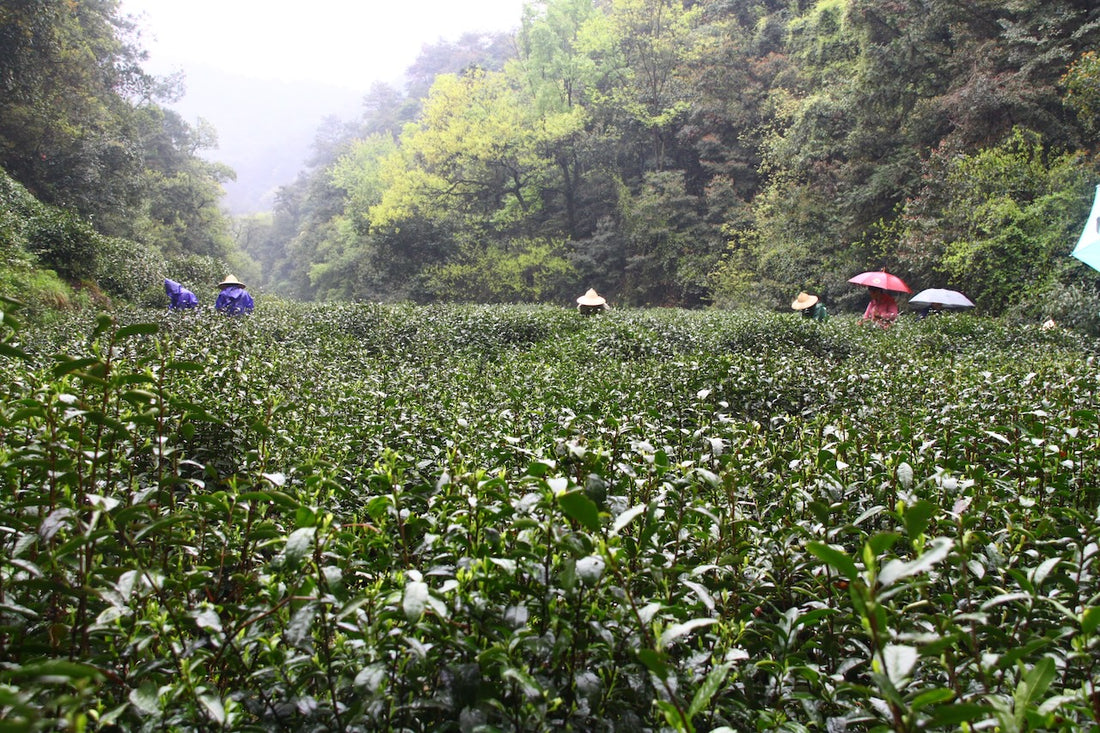Dragon Well (Longjing) Tea Cultivars: Qunti vs #43 vs Wu Niu Zao

Share
Longjing (or 'Dragon Well'), is a famous Chinese green tea characterised by its flat, green-yellowish leaves and roasted nutty aroma. Zhejiang province's specialised tea farms produces tons of Longjing annually. Yet, not all Dragon Well teas are created equal.
The main factor distinguishing different kinds of Longjing teas is the variety of tea plants used, also known as cultivars. Qunti Zhong, Longjing #43 and Wu Niu Zao are the most common cultivars for producing Dragon Well tea. In this article, we'll explore the unique characteristics of each of these cultivars.
Qunti Zhong: The original cultivar

Qunti Zhong, locally also known as Tu Zhong (native cultivar), Lao Longjing (old Longjing) and Laoshu (old tree cultivar), is the earliest tea cultivar used to produce Longjing tea. According to the legend, it rose to fame during the Qing Dynasty, after it was discovered by Emperor Qianlong.
Originating from Hangzhou city, this plant thrives in different seasons. Its history trace back to Tiantai Mountain and Jiukeng Township, which are part of Chun'an County in Zhejiang Province. This varietal is primarily cultivated near the West Lake region Hangzhou. Hence, the tea is also known as 'West Lake Dragon Well'.

Qunti Zhong Longjing tea is harvested later than other Longjing varieties. The majority of the harvest becomes available on the market after the Qingming festival (early April).
Some green tea lovers may instinctively prefer early harvest green teas. However, this isn't possible when buying Longjing made from the Qunti cultivar. It's therefore important to know what kind of longjing you're buying.

Tea pickers in Meijiawu village heading out early in the morning to pick tea.
Qunti Zhong is not easy to wok-roast. Its leaves vary in size and thickness, requiring multiple rounds of roasting to prevent breakage. Allowing the leaves to rest between rounds aids in redistributing moisture, maintaining structural resilience.

Longjing tea leaves picked by hand and stored in a large bamboo basket.
The color of Qunti Zhong dry tea leaves is golden-green, richer than other varieties, and the tea is vibrantly yellow. The flavour is vibrant, sweet, and invigorating; boasting a luxurious texture and intense flavour, complemented by mineral, vegetal and nutty notes with a touch of astringency.
If you're interested of tasting the different cultivars yourself, you can find them in our EU store!
If you're not based in the EU, then make sure to buy green tea in our global store with direct shipping service from China: Chinese green tea.
Longjing #43: The beautiful cultivar

Since the 90’s a new type of Longjing cultivar has prevailed: the Longjing #43 or locally called Xin Shu (new tree cultivar). This tea plant was selected by the Tea Research Institute of the Chinese Academy of Agricultural Sciences during the 60s and the 70s.
Utilising the single plant breeding approach from early germinated Qunti Zhong trees, they developed a plant producing small, flawless, and early buds. Additionally, it's visually appealing, more resilient, and it harvests sooner.
Longjing #43 buds around the middle of March. Due to its dense branching and strong reproductive ability, orderly germination, picking tolerance, and low tenderness retention, it's the most widely used cultivar for producing longjing tea in Zhejiang province. Longjing #43's dry leaves offer a delightful fragrance and possess a vibrant, lush appearance, showcasing vitality and richness compared to Qunti Zhong. Moreover, varietal #43 features compact, robust buds, evoking the elegant shape of other traditional green teas such as Queshe (雀舌) or 'Sparrows Tongue'. Longjing 43 also features a unique red tip at the end of its tea stem, due to its rich anthocyanins content.
Wu Niu Zao: The earliest cultivar

At last we have the Wu Niu Zao cultivar, named after the town of origin 'Wu Niu' and the Chinese word for 'early' (Zao), is cultivated for over 300 years.
Being the first farm to offer Longjing tea in the spring season is crucial for the competitive market of green teas in China. To put this into perspective, a mere day or two ahead can result in hundreds of extra dollars per pound of tea. Neither the Qunti Zhong nor the #43 can compete with the Wu Niu Zao's early harvesting period.
One reason this cultivar sprouts earlier is because the production region (Wu Niu) is located almost 300 kilometers (185 miles) south of the West Lake production area. Depending on weather conditions, the first harvest of Wu Niu Zao Longjing tea may already be available around the end of February.
Due to the early germination and the high yield of the Wu Niu Zao cultivar, some farmers around the West Lake tea region have partially switched to cultivating Wu Niu Zao in recent years.
The Wu Niu Zao Longjing dry tea leaves are vividly green. The tea buds are short, plump, and thick, with downy hairs on its surface. The leaves appear flat, smooth, neat, and uniform.
Due to the harvesting season, most Qunti Zhong longjing teas Yuqian teas, while Longjing #43 and Wu Niu Zao are mostly Mingqian teas and Sheqian teas, respectively. To learn more about these terms, we recommend you to read this guide: What is Sheqian, Mingqian and Yuqian tea?
So what's the best Longjing tea cultivar? That's all up to your taste buds!
